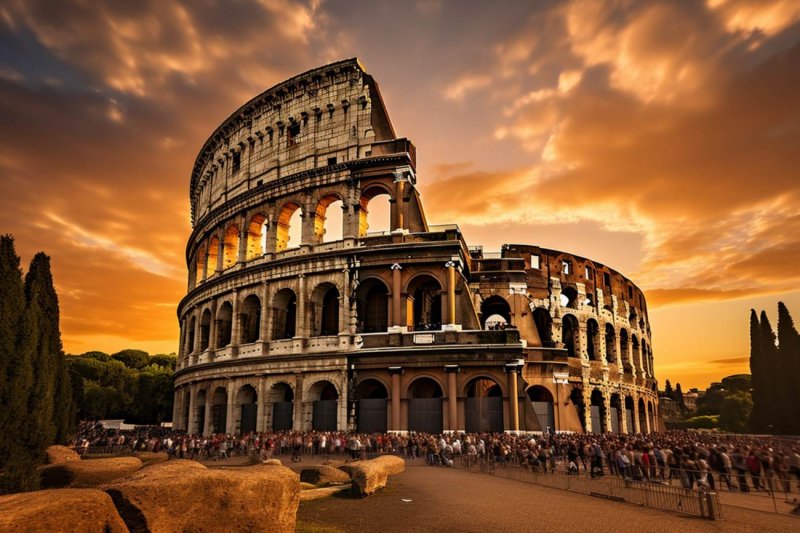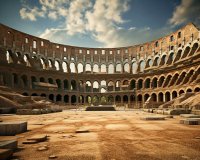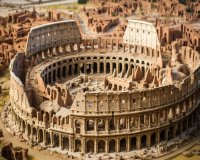Discover the Secrets of the Colosseum

Discover the Secrets of the Colosseum in Rome
The Colosseum in Rome, also known as the Flavian Amphitheatre, is one of the most iconic and well-preserved ancient structures in the world. This remarkable amphitheater has stood the test of time, bearing witness to centuries of history and intrigue. In this article, we will delve into the secrets and fascinating facts surrounding this colossal structure that has captivated the imagination of people from all corners of the globe.
The Colosseum was constructed in AD 70-80 under the emperor Vespasian and his son Titus. It is located in the heart of Rome and could hold an estimated 50,000 to 80,000 spectators. The amphitheater was primarily used for gladiatorial contests, animal hunts, mock sea battles, and various other public spectacles.
The Construction and Architecture
One of the most intriguing aspects of the Colosseum is its architecture. The elliptical shape of the structure allowed for excellent sightlines, ensuring that all spectators had a clear view of the events in the arena. The exterior of the Colosseum was a grand spectacle in itself, with three tiers of arched openings that added to its majestic appearance.
But what makes the Colosseum truly remarkable is the innovative engineering that went into its construction. The Romans were known for their architectural prowess, and the Colosseum is a prime example. The amphitheater was equipped with a complex system of underground tunnels and chambers, providing a hidden world beneath the arena floor. These passageways were used for various purposes, including the transportation of animals and gladiators to the arena.
The Spectacles and Events
The Colosseum hosted a wide range of events that entertained the Roman populace for centuries. Gladiatorial combat, in which trained fighters battled to the death, was one of the most popular spectacles. It was a brutal but captivating form of entertainment for the people of ancient Rome.
Another spectacle was the reenactment of famous battles and naval engagements. The Colosseum's underground chambers were filled with water, allowing for the staging of these grand mock sea battles. The water was then drained to create a blank canvas for the next event.
Wild animal hunts, known as "venationes," were also a frequent occurrence. Exotic animals, including lions, tigers, and elephants, were brought into the arena to fight against each other or even against human gladiators. These hunts showcased the might and power of the Roman Empire.
The Colosseum's Secrets
Throughout its history, the Colosseum has revealed many secrets and mysteries. One such secret is the vast and intricate network of tunnels and trapdoors beneath the arena. These passageways were essential for the efficient and dramatic staging of events. Today, visitors can explore some of these hidden areas and gain a better understanding of the mechanics behind the Colosseum's grandeur.
Another mystery surrounding the Colosseum is the actual number of people and animals who perished within its walls. While estimates vary, it is clear that countless lives were lost during the various spectacles and battles. The Colosseum serves as a powerful reminder of the brutality and extravagance of ancient Rome.
Modern-Day Colosseum
Today, the Colosseum stands as a symbol of both ancient history and the resilience of human engineering. It is a UNESCO World Heritage site and a must-visit destination for tourists from around the world. The structure has undergone extensive restoration and preservation efforts to ensure that it continues to awe and inspire future generations.
Visiting the Colosseum is a journey back in time, an opportunity to explore the secrets and stories of an iconic monument that has left an indelible mark on the history of Rome and the world.
In conclusion, the Colosseum in Rome is a marvel of ancient architecture, engineering, and entertainment. Its secrets, from the underground passages to the grand spectacles that once took place within its walls, continue to captivate and intrigue visitors. As you step into this iconic amphitheater, you'll be transported to a time when the roar of the crowd and the clash of gladiators filled the air, making it an experience you'll never forget.
Rome: Colosseum, Palatine Hill, and Roman Forum Guided Tour
Discover the ancient glory of Rome with a guided tour that takes you through three of the Eternal City’s most significant remnants: the Colosseum, Palatine Hill, and Roman Forum. Skip the line and immerse yourself in the history of Ancient Rome with an expert guide who will bring the ruins to life.
About this Activity
Explore the Colosseum, where epic battles unfolded, and gain insights into its historical significance. Visit Palatine Hill, the spot chosen by Romulus to found Rome, and enjoy breathtaking views overlooking the Roman Forum as you delve into its fascinating history.
Experience Highlights
- Skip the line and spend three immersive hours exploring the Colosseum, Palatine Hill, and Roman Forum.
- Benefit from an expert guide sharing myths and historical tales of gladiators, beasts, and emperors.
- Small groups of 24 people or less with audio headsets for an intimate experience.
What's Included
- Colosseum, Roman Forum, and Palatine Hill skip-the-line tickets
- Arena Floor access (if option selected)
- Tour guide with expertise in history and archaeology
- Headsets for clear audio guidance
- Hotel pickup and drop-off (if selected)
Important Information
- Meeting point may vary based on the chosen option: English Private Tour, English Group Tour, Semi-Private English Small Group Tour, Spanish Group Tour.
- Ensure you have your passport or ID card and wear comfortable shoes.
- Items not allowed: baby strollers, large bags, backpacks.
- Arrive 15 minutes prior to departure; late arrivals are not eligible for a refund.
Customer Reviews
Overall Rating: 4.7/5 based on 8178 reviews
Guide: 4.8/5 | Value for Money: 4.4/5 | Service: 4.7/5 | Organization: 4.6/5
One visitor mentioned the guide's enthusiasm, while another praised a guide named PG for his deep knowledge and entertaining narrative. However, there was also feedback about a guide focusing too much on personal anecdotes and not enough on history.
The History and Architecture of the Colosseum in Rome
The Colosseum, also known as the Flavian Amphitheatre, is an iconic symbol of ancient Rome and one of the most famous landmarks in the world. It stands as a testament to the architectural and engineering prowess of the Roman Empire and has a rich history that continues to captivate people from all around the globe.
History
The construction of the Colosseum began in AD 70-72 under the rule of Emperor Vespasian of the Flavian dynasty. It was completed in AD 80 by his son, Titus. The amphitheatre was built on the site of Nero's former palace, which had been destroyed by the Great Fire of Rome in AD 64. The Colosseum was a grand gesture by the Flavian emperors to gain favor with the Roman people.
It was primarily used for various forms of public spectacles, including gladiator contests, animal hunts, mock sea battles, and other forms of entertainment. The Colosseum could hold an estimated 50,000 to 80,000 spectators, making it one of the largest amphitheaters of its time.
Over the centuries, the Colosseum has seen a range of uses, including as a quarry for building materials during the Middle Ages and a source of religious inspiration in the 18th and 19th centuries. It has also undergone various phases of restoration and preservation efforts to maintain its structural integrity.
Architecture
The Colosseum's architecture is a marvel of ancient engineering and design. It stands as a testament to the skill and innovation of Roman architects and builders. The amphitheater is constructed mainly of concrete and sand, with a complex network of arches, vaults, and columns providing its structural support.
| Architectural Features |
Description |
| Exterior Facade |
The outer wall of the Colosseum featured three tiers of arches and columns, which gave it a distinctive and impressive appearance. |
| Hypogeum |
Beneath the arena floor, there was a vast underground network of tunnels and chambers, known as the hypogeum, used for preparing the spectacles and housing animals and gladiators. |
| Seating Arrangements |
The seating tiers were divided into different sections for various social classes, with the best seats reserved for the elite. |
| Retractable Awning |
The Colosseum had a retractable awning system known as the velarium, which could provide shade for the spectators. |
The Colosseum was designed with precision to ensure that spectators could enter and exit quickly, and it had numerous vomitoria (passageways) to facilitate this. The elliptical shape of the arena allowed for excellent visibility from any seat in the house.
Unfortunately, over the centuries, the Colosseum has suffered damage from earthquakes, fires, and human activities, leading to its partially ruined state today. Despite this, the Colosseum remains a symbol of ancient Rome's architectural and cultural achievements, and it continues to attract millions of tourists who are fascinated by its grandeur and historical significance.
Conclusion
The Colosseum, with its remarkable history and architectural splendor, is a timeless monument to the glory of ancient Rome. It stands as a testament to the ingenuity of Roman engineers and the enduring fascination with the spectacles that once graced its arena. Visiting the Colosseum is not only a journey through time but also an opportunity to marvel at the architectural achievements of a civilization that has left an indelible mark on the world.
Rome: Guided Tour to the Roman Forum and Palatine Hill
Explore the ancient wonders of Rome on a guided walking tour to the Roman Forum and Palatine Hill with skip-the-line tickets, led by expert guides from Vivicos International Travel.
On this 1.5-hour tour, journey back in time as you walk through the iconic Roman Forum, once the heart of ancient Rome. Discover the remnants of triumphal processions, elections, and public speeches. Marvel at the architectural wonder of the Temple of Romulus and delve into the fascinating history of the site with engaging stories from your tour guide.
Climb Palatine Hill and enjoy breathtaking views of the ruins from above. Explore the House of Augustus, adorned with a wide collection of frescoes, providing a deeper insight into Ancient Rome and its rulers.
This tour, offered in English and Spanish, allows you to skip the line, ensuring quick entry through express security checks. Individual headphones are provided, enhancing your experience. Please note that this express tour does not include entry to the Colosseum.
Meeting Point: Via Frangipane 30, just off Via Fori Imperial under the small arch attached to the tourist information office.
Price: From lei 161.58 per person
Customer Reviews: Rated 4.2/5 based on 106 reviews. Visitors praise the knowledgeable guides, engaging storytelling, and the opportunity to skip the line for an immersive experience.
Additional Options:
- Rome: Palatine Hill & Roman Forum Ticket w/ Multimedia Video: Explore at your own pace with a multimedia guide. Price: From lei 159.09 per person.
- Rome: Semi-Private Roman Forum Myths and Legends Guided Tour: Dive into the myths and legends of ancient Rome in a small group setting. Price: From lei 218.75 per person.
- Rome: Roman Forum & Palatine Hill Entry Ticket & Audio Tour: Enjoy a self-guided audio tour of these historic sites. Price: From lei 164.06 per person.
- Rome: Colosseum Palatine Hill and Roman Forum Guided Tour: Explore the Colosseum, Palatine Hill, and Roman Forum with skip-the-line access. Price: From lei 298.25 per person.
Gladiator Battles in the Colosseum: A Glimpse into Ancient Rome's Spectacular Spectacles
The Colosseum in Rome, also known as the Flavian Amphitheatre, is an iconic symbol of ancient Roman engineering and entertainment. One of the most thrilling and, at times, gruesome spectacles that took place within its walls were the Gladiator battles. These epic contests were a central element of Roman culture, drawing enormous crowds to witness the combat and bloodshed.
Gladiators, often slaves or prisoners of war, were trained to fight in the arena. They were pitted against each other, wild animals, and sometimes even condemned criminals. These battles were not just physical clashes but also a reflection of the Roman society's values and the emperor's desire to keep the population entertained and controlled.
The Colosseum: A Spectacle of Grandeur
The Colosseum, completed in 80 AD under Emperor Titus, is a marvel of architecture. With a seating capacity of up to 80,000 spectators, it was the largest amphitheater in the Roman Empire. The arena floor was a hive of activity where the gladiators, along with exotic animals, would face off in deadly confrontations. The spectators, divided into different social classes, would eagerly await the bloodthirsty battles about to unfold.
| Types of Gladiators |
Weapons and Armor |
| Lanista |
Lance and Dagger |
| Murmillo |
Gladius (sword) and Scutum (shield) |
| Retiarius |
Trident and Net |
There were various types of gladiators, each with their unique weaponry and armor. Lanista, equipped with a lance and dagger, would face off against the formidable Murmillo, who wielded a gladius (sword) and scutum (shield). The Retiarius, on the other hand, used a trident and a net in their battles.
The choice of gladiator and weaponry added an element of unpredictability and excitement to the contests. These battles were not mere fights for survival; they were well-choreographed performances, with intricate strategies, honed skills, and dramatic flair.
The Role of Gladiator Battles in Roman Society
Gladiator battles served multiple purposes in Roman society. Firstly, they were a form of entertainment, offering the masses a distraction from their daily lives and struggles. The grandeur of the Colosseum and the violence of the battles were meant to awe and captivate the audience.
Secondly, these contests were a means of demonstrating the power and authority of the emperors. By sponsoring and organizing the games, they could garner popularity and maintain control over the people. The extravagance of the events was a symbol of Rome's might and wealth.
Finally, gladiator battles were a tool for social control. The hierarchy of seating within the Colosseum reflected the social structure of Rome. The emperor, senators, and nobles had the best seats, while common citizens and slaves were seated in the upper tiers. This division reminded the people of their place in society and their dependence on the emperor for their entertainment and welfare.
The Decline of Gladiator Battles
Gladiator battles continued for centuries, but as Rome evolved and Christianity gained prominence, the brutal contests began to lose favor. With the decline of the Roman Empire, the Colosseum fell into disrepair, and the gladiatorial games were eventually banned by Emperor Honorius in 404 AD.
Today, the Colosseum stands as a historic monument, a testament to the grandeur and brutality of ancient Rome. It serves as a reminder of a bygone era when the cheers of the crowd and the clash of weapons filled the air, making it a place of both wonder and reflection.
In conclusion, the gladiator battles in the Colosseum were a spectacle that embodied the values and power dynamics of ancient Rome. While they may have been gruesome and brutal, they are an integral part of Roman history and have left an indelible mark on the world's cultural memory.







